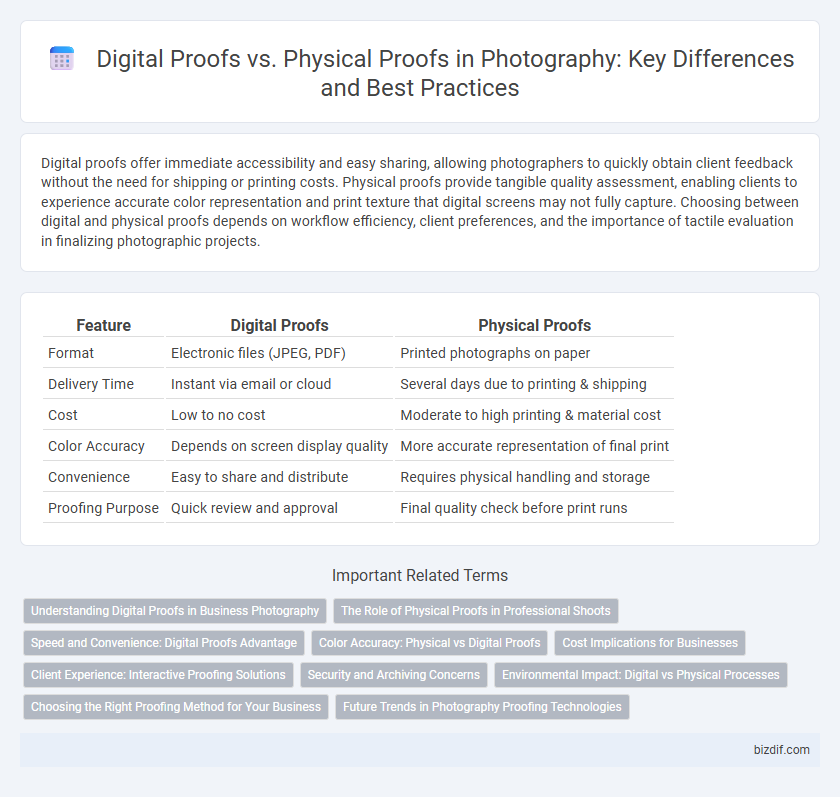Digital proofs offer immediate accessibility and easy sharing, allowing photographers to quickly obtain client feedback without the need for shipping or printing costs. Physical proofs provide tangible quality assessment, enabling clients to experience accurate color representation and print texture that digital screens may not fully capture. Choosing between digital and physical proofs depends on workflow efficiency, client preferences, and the importance of tactile evaluation in finalizing photographic projects.
Table of Comparison
| Feature | Digital Proofs | Physical Proofs |
|---|---|---|
| Format | Electronic files (JPEG, PDF) | Printed photographs on paper |
| Delivery Time | Instant via email or cloud | Several days due to printing & shipping |
| Cost | Low to no cost | Moderate to high printing & material cost |
| Color Accuracy | Depends on screen display quality | More accurate representation of final print |
| Convenience | Easy to share and distribute | Requires physical handling and storage |
| Proofing Purpose | Quick review and approval | Final quality check before print runs |
Understanding Digital Proofs in Business Photography
Digital proofs in business photography offer quick and cost-effective ways to review images before final production, enabling clients to make informed decisions without the need for physical copies. These proofs maintain high resolution and color accuracy, allowing detailed assessment of composition and lighting essential for corporate branding. Utilizing digital proofs streamlines the approval process and reduces overhead, making them an invaluable tool in professional photography workflows.
The Role of Physical Proofs in Professional Shoots
Physical proofs in professional photography offer tangible evidence of shot quality, enabling precise color accuracy and detail assessment that digital proofs may miss. They serve as essential tools for client approval and ensure final prints meet exact standards before mass production or delivery. The tactile nature of physical proofs also facilitates better communication between photographers and clients regarding texture, finish, and overall aesthetic.
Speed and Convenience: Digital Proofs Advantage
Digital proofs offer unparalleled speed and convenience, allowing photographers to instantly share high-resolution images with clients through email or cloud platforms. Clients can review, comment, and approve selections from any location without waiting for physical delivery or handling prints. This streamlined process significantly reduces turnaround time and enhances collaboration efficiency compared to traditional physical proofs.
Color Accuracy: Physical vs Digital Proofs
Physical proofs offer superior color accuracy by displaying prints under controlled lighting conditions, ensuring true-to-life color representation that digital screens may fail to replicate due to variations in device calibration. Digital proofs rely on monitor color profiles and ambient lighting, which can lead to discrepancies in color perception across different devices. For critical projects demanding exact color matching, physical proofs remain the preferred choice to validate final print quality.
Cost Implications for Businesses
Digital proofs significantly reduce costs for photography businesses by eliminating expenses related to printing, shipping, and material waste. Physical proofs involve ongoing costs such as high-quality paper, ink, and packaging, which cumulatively impact profit margins. Opting for digital proofs enhances scalability and quick client approvals, ultimately maximizing operational efficiency and reducing overhead.
Client Experience: Interactive Proofing Solutions
Interactive proofing solutions significantly enhance the client experience by offering real-time feedback on digital proofs, allowing clients to annotate, approve, or request changes instantly. Unlike physical proofs, which require mailing and delay responses, digital proofs streamline communication and accelerate project timelines. These tools also provide a centralized platform for collaboration, ensuring clarity and satisfaction throughout the photography approval process.
Security and Archiving Concerns
Digital proofs offer enhanced security through encrypted storage and controlled access, reducing the risk of unauthorized duplication or tampering. Physical proofs, while tangible and easy to archive, face vulnerabilities such as deterioration, loss, or damage over time, complicating long-term preservation. Archiving digital proofs allows for scalable storage solutions with metadata tagging, improving retrieval accuracy compared to traditional physical proof management.
Environmental Impact: Digital vs Physical Processes
Digital proofs minimize environmental impact by eliminating the need for paper, chemicals, and transportation associated with physical proofs. Physical proofs require resources like photographic paper, inks, and chemical processing agents, contributing to waste and pollution. Choosing digital proofs supports sustainable photography practices by reducing material consumption and carbon emissions.
Choosing the Right Proofing Method for Your Business
Digital proofs provide a cost-effective and efficient way for clients to review and approve images quickly, making them ideal for businesses with fast turnaround times or large-scale projects. Physical proofs offer tangible color accuracy and print quality that digital displays cannot replicate, essential for high-end photography clients who prioritize fine detail and true-to-life presentation. Evaluating your client needs, project scope, and budget will help determine the optimal proofing method to enhance satisfaction and streamline the workflow.
Future Trends in Photography Proofing Technologies
Emerging trends in photography proofing emphasize the integration of AI-driven digital proofs that enable real-time edits and client feedback through cloud-based platforms. Advances in augmented reality (AR) and virtual reality (VR) are transforming physical proofs by providing immersive visualization experiences before prints are finalized. Sustainable materials and eco-friendly printing technologies are also influencing the future of physical proofs, aligning with global demands for environmental responsibility in photography workflows.
Digital Proofs vs Physical Proofs Infographic

 bizdif.com
bizdif.com